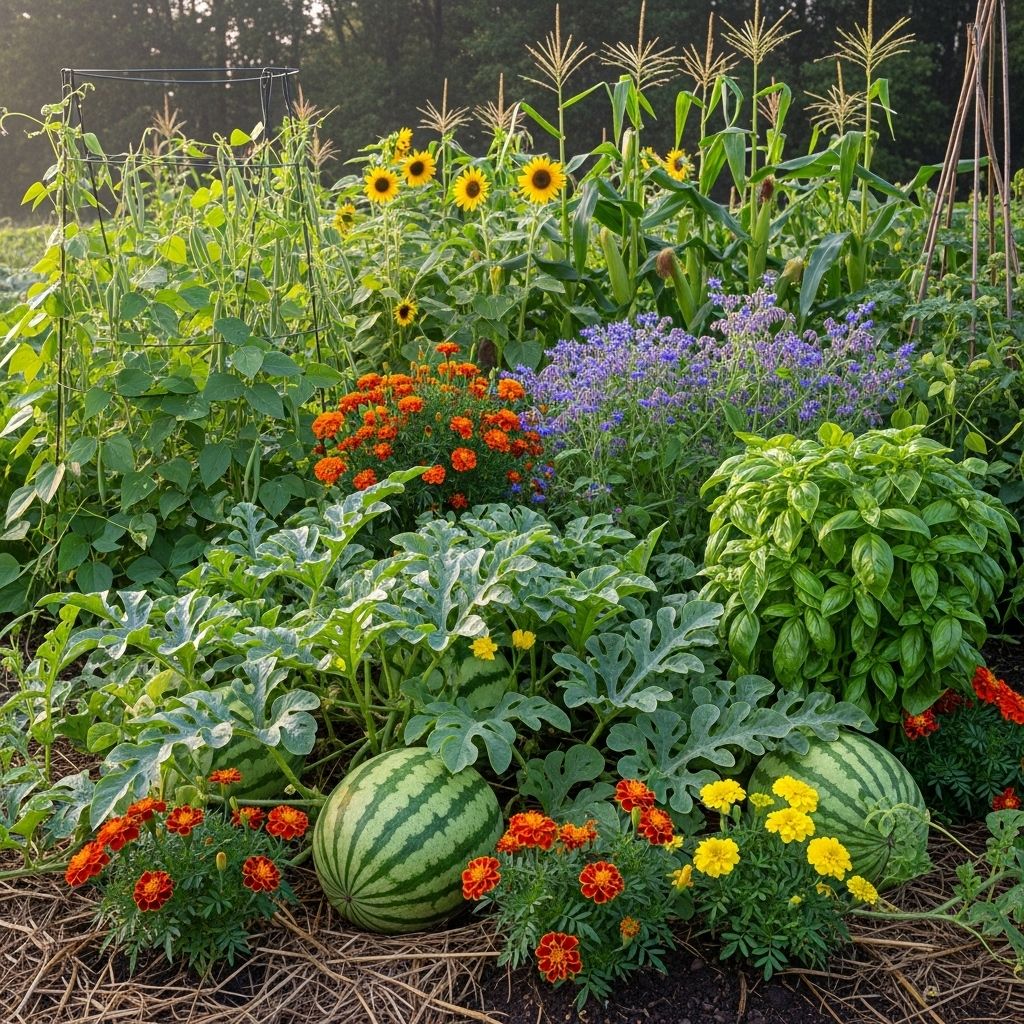Companion Plants For Watermelon: 20 Perfect Garden Pairings
Unlock the secrets to thriving watermelon vines with these 20 perfect companion plants for pest control, healthy soil, and bigger harvests.

Image: HearthJunction Design Team
20 Perfect Companion Plants for Watermelons
Watermelons are a quintessential summer crop, famous for their sweet, juicy fruit and sprawling vines. Growing thriving watermelons, however, can be challenging without the right garden environment. The key to success often lies in companion planting—strategically selecting neighboring plants that provide pest control, enrich the soil, and support healthy growth. This comprehensive guide explores 20 of the best watermelon companion plants, how they help, which to avoid, and expert tips for planning a productive patch.
Understanding Watermelon Companion Planting
Companion planting is the practice of positioning certain plants together to take advantage of natural relationships. For watermelons, effective companions do not compete for space, sunlight, or nutrients, and may even provide benefits like pest deterrence, soil enrichment, or improved pollination. Carefully selected companions can make a significant difference in the success of your watermelon patch.
Top 20 Companion Plants for Watermelons
Here’s a closer look at plants that pair particularly well with watermelon, along with specific benefits and important planting notes for each one.
Basil
- Pest control: Basil’s potent aroma masks watermelon scent, confusing and deterring pests such as thrips.
- Growth habit: With shallow roots and a bushy growth, basil can be planted between watermelon rows or around the borders, provided they’re spaced appropriately.
Beans and Peas
- Nitrogen fixers: Beans and peas pull nitrogen from the air, enriching the soil and benefiting watermelon growth.
- Traditional pairing: Pole beans can even be grown using corn or sunflowers as a living trellis, with watermelon acting as a ground cover in the time-honored “Three Sisters” method.
- Minimal competition: Because beans and peas do not compete for soil nitrogen, they won’t deprive watermelon vines of essential nutrients.
Radishes
- Pest deterrent: Radishes repel cucumber beetles and squash bugs, which threaten watermelon vines.
- Fast-growing: Plant radishes around the perimeter or between watermelon plants for a quick return and ongoing pest protection.
Marigolds
- Repels pests: Marigolds deter nematodes, whiteflies, and tomato hornworms with their strong scent and natural compounds.
- Companion for all: Their non-invasive growth habit makes them ideal for bordering watermelon patches.
Oregano
- Pest barrier: Oregano releases aromatic compounds that help repel flying insects.
- Non-competitive: Use as a border plant to enhance pest resistance without crowding watermelon vines.
Sunflowers
- Provides support: Tall sunflowers can serve as support for climbing beans or peas while offering light shade for watermelon vines during especially hot afternoons.
- Pollinator magnet: Sunflowers attract beneficial pollinators and predatory insects, boosting fruit set and natural pest control.
Nasturtium
- Trap crop: Nasturtiums attract aphids, drawing them away from watermelon vines.
- Pollinator-friendly: Their vibrant flowers bring pollinators, improving melon yields.
Lettuce
- Early season interplant: Lettuce grows quickly and is harvested before watermelon vines begin to sprawl, maximizing space and providing ground cover to suppress weeds.
- Minimal competition: Shallow roots mean lettuce won’t compete with watermelon for resources.
Garlic and Onions
- Pest repellent: Their pungent scent deters aphids, beetles, and other problematic insects.
- Space efficiently: Plant garlic or onions along the border to keep pests at bay without encroaching on watermelon root space.
Chives
- Pest prevention: Like onions and garlic, chives help repel aphids and beetles.
- Small footprint: Chives can be tucked into small spaces at the edge of beds.
Dill
- Attracts beneficials: Dill flowers lure predatory wasps and hoverflies, which prey on aphids and caterpillars.
- Let bolt: Allowing dill to flower maximizes its pest control benefits.
Mints (in containers)
- Strong repellent: Mint deters aphids, ants, and flea beetles—but always plant in containers, as mint can aggressively spread and take over your melon patch.
Catnip
- Repels pests: Catnip wards off flea beetles and squash bugs.
- Keep contained: Like mint, catnip is best grown in pots to prevent garden domination.
Borage
- Pollinator attraction: Borage is a champion at drawing bees, central to pollinating watermelon flowers.
- Soil improvement: Its deep taproot brings up nutrients, and its decomposing foliage adds trace minerals to the soil.
Buckwheat
- Smothers weeds: Fast-growing buckwheat outcompetes weeds and provides green mulch when chopped and dropped.
- Attracts insects: Buckwheat flowers offer nectar for pollinators and beneficial predatory insects.
Spinach
- Interplant early: Like lettuce, spinach matures before melons spread, making it a great spring companion.
Yarrow
- Natural insectary: Yarrow’s umbrella-shaped flowers are magnets for ladybugs, lacewings, and hoverflies—all beneficial predators.
Tansy
- Repels beetles and ants: This aromatic herb helps to keep problematic insects away but should be grown outside melon beds due to its potential invasiveness.
Calendula
- Pest trap: Calendula attracts aphids, diverting them from watermelon vines and providing both color and nectar for pollinators.
Corn
- Three Sisters method: Use corn as a support for climbing beans, with watermelon sprawling at the base as a living mulch and weed suppressor.
- Light filter: Tall corn can provide dappled shade during hot periods, protecting young vines from leaf scorch.
How Companion Plants Benefit Watermelons
Companion planting with watermelons isn’t just about deterring pests; it’s about cultivating a multi-layered ecosystem. Here’s how these plant partnerships work:
- Pest Control: Aromatic herbs and flowers confuse and repel insects, minimizing crop losses without chemicals.
- Pollination: Flowering companions attract bees and beneficial insects essential for fruit set.
- Soil Health: Nitrogen-fixing legumes and deep-rooted biodynamic accumulators like borage and buckwheat enhance soil fertility and structure.
- Microclimate Management: Taller plants provide shade and wind protection, while low, fast-growing companions offer living mulch.
- Weed Suppression: Fast-growing greens fill gaps early in the season, keeping weed pressure low until melons take over.
Plants to Avoid Near Watermelons
Not every plant pairs well with watermelon. Some compete for space, attract similar pests, or hinder melon growth. Avoid the following around your watermelon patch:
- Cucumbers and other melons: Susceptible to the same diseases and pests, increasing risk of infestations.
- Potatoes: Compete for nutrients and may encourage fungal pathogens.
- Zucchini and summer squash: Share similar growth habits and pest profiles, making overcrowding and competition common.
- Pumpkins: Create excessive shade and compete aggressively for root space.
Tips for Successful Watermelon Companion Planting
- Space companions thoughtfully: Allow sprawling watermelon vines plenty of room—plant companions at the edges or between rows.
- Use containers for aggressive herbs: Mint and catnip thrive in pots placed near (but not inside) melon beds.
- Stagger planting times: Early greens can be grown before vines spread, utilizing space and suppressing weeds.
- Rotate annually: Move melon patches and companions to reduce disease risk and balance soil nutrients over time.
- Monitor light: Ensure tall companions do not shade watermelons excessively—opt for plants that provide filtered, not dense, shade.
Sample Watermelon Companion Planting Chart
| Companion Plant | Benefit | Best Position |
|---|---|---|
| Basil | Repels thrips | Between rows |
| Beans | Fixes nitrogen | Next to melons or with corn |
| Marigold | Repels nematodes | Patch border |
| Sunflower | Pollinator support | North or west side |
| Lettuce | Weed suppression | Early, between vines |
| Garlic/Onion | Pest deterrent | Bed edge |
| Dill | Attracts beneficials | Near patch |
Frequently Asked Questions (FAQs)
Q: Can watermelons be grown in containers with companions?
A: Yes, watermelons can be grown in large containers (at least five gallons) or vertical planters. Interplant with shallow-rooted herbs such as basil or flowers like marigold for pest deterrence. Always ensure adequate sunlight and space for vine expansion.
Q: What is the Three Sisters method, and can it include watermelon?
A: The Three Sisters method is a Native American interplanting system using corn, beans, and squash. Substituting watermelon for squash works well: corn (as a trellis), pole beans (for nitrogen), and watermelon (as ground cover) form a productive, symbiotic trio.
Q: How close can companion plants be to watermelon vines?
A: Companions should be at least 12 inches from the watermelon main stem. Border and edge planting is preferred so vines have room to sprawl without fierce nutrient competition or shading.
Q: Which herbs should not be grown with watermelons?
A: Strongly spreading herbs like mint and catnip should only be grown in containers. Avoid planting aromatic perennials directly in beds as they may outcompete or overwhelm melons.
Q: Can flowers really improve watermelon harvests?
A: Absolutely! Flowers like marigold, nasturtium, calendula, and borage not only attract critical pollinators but also repel pests, resulting in more fruit set and healthier vines.
Conclusion
Companion planting with watermelons is an art and a science, balancing the needs of sprawling vines with the benefits of thoughtful partnerships. From pest-fighting herbs and pollinator-attracting flowers to nitrogen-fixing legumes and weed-suppressing greens, these 20 companions help maximize harvests naturally. With strategic planning and care, your watermelon patch will thrive, yielding sweet, abundant fruit through the heart of summer.
References
Read full bio of Srija Burman












